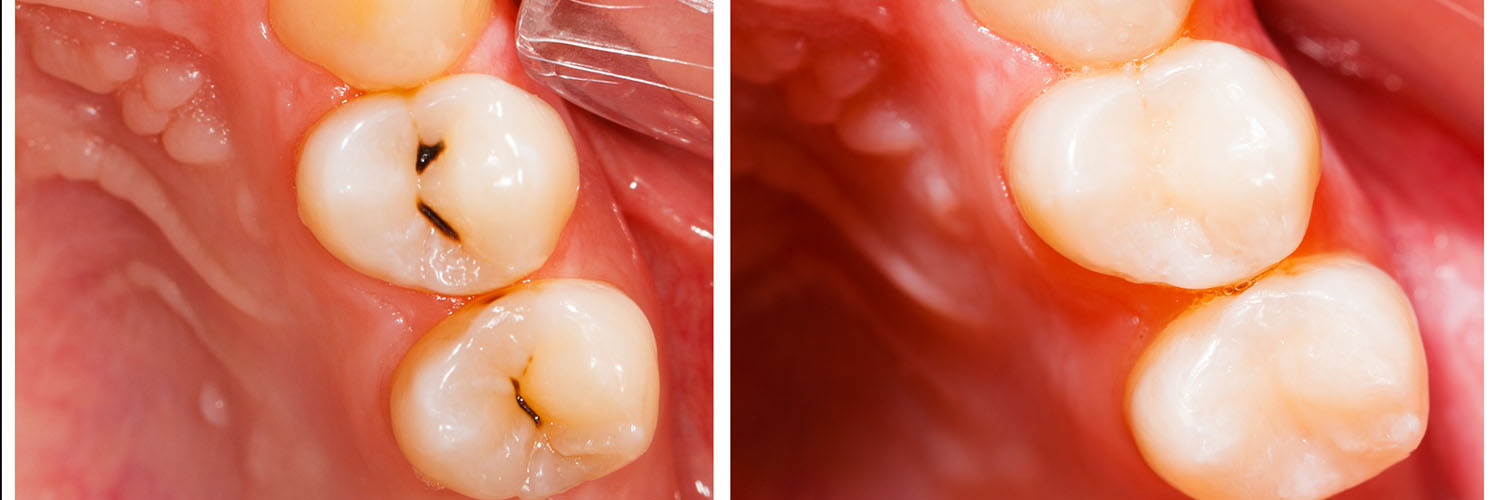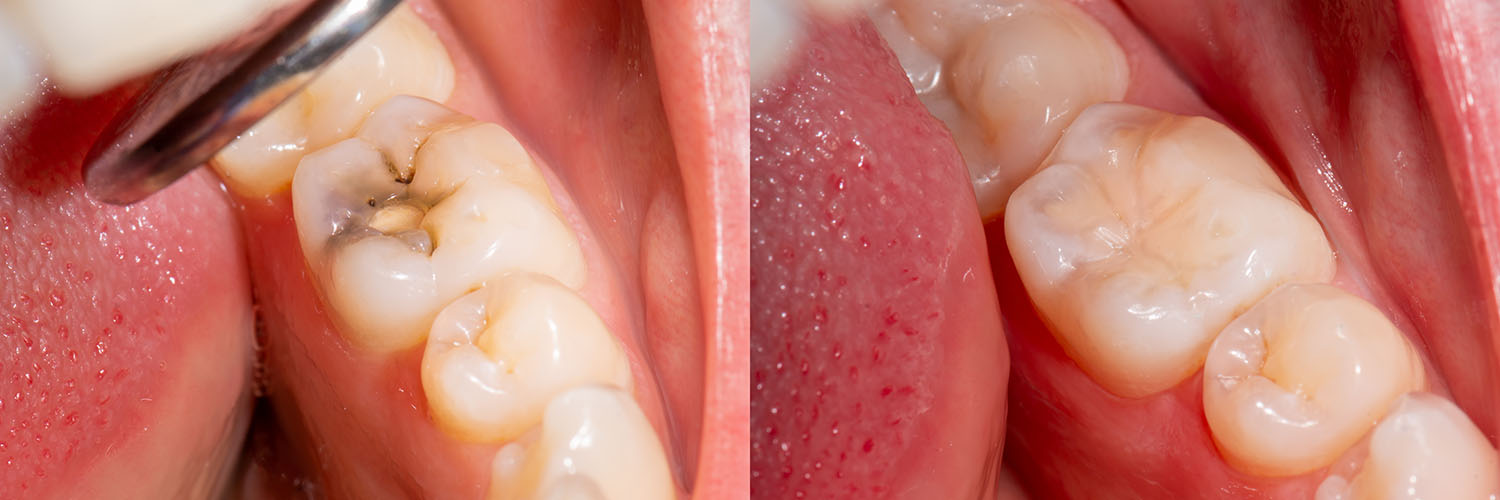
When a tooth’s enamel or inner dentin is compromised by decay or minor fracture, a filling restores the tooth’s shape and function while sealing out bacteria. A well-placed filling stops damage from progressing, preserves as much natural tooth structure as possible, and helps maintain comfortable chewing and normal bite alignment.
Fillings are one of dentistry’s most common restorative procedures because they effectively treat the early stages of tooth decay and small mechanical defects. The goal is not just to remove damaged material, but to rebuild a resilient surface that integrates with the surrounding tooth and supports long-term oral health.
At Newpoint Family Dental, our approach is conservative and precise: we remove diseased tissue, select the most appropriate restorative material, and shape the filling so it looks natural and performs reliably. We aim to minimize discomfort and maximize durability so patients can return to everyday activities quickly.
Humans have attempted repairs to broken and decayed teeth for millennia, and the materials and methods have evolved dramatically. Early restorers used everything from beeswax to metals, and over time dentists developed materials that balance strength, tooth conservation, and esthetics.
Today’s restorative toolbox includes mercury-free, tooth-colored options alongside traditional metal restorations. Advances in adhesive technology and ceramic fabrication have expanded choices so clinicians can match the material to the location of the tooth, the extent of damage, and the patient’s goals for appearance and longevity.
Every treatment plan begins with a careful examination and candid discussion about options. We consider factors such as the size and location of the cavity, bite forces, cosmetic concerns, and the overall condition of the tooth. That lets us recommend a filling that balances strength, appearance, and long-term predictability.

Material selection matters. Different filling materials perform better in specific parts of the mouth and under different conditions. Some are ideal where chewing forces are high, while others prioritize seamless color matching with adjacent teeth. Knowing the strengths and limitations of each option helps patients make informed decisions.
Rather than a one-size-fits-all approach, contemporary dentistry pairs the right material with the clinical need: durable restorations for back teeth, highly aesthetic solutions for front teeth, and fluoride-releasing options where additional protection is desirable. Your clinician will explain why a particular material is recommended for your situation.
Beyond appearance and strength, modern filling choices also reflect advances in bonding systems and laboratory processes. Indirect restorations such as inlays or onlays can be fabricated with exceptional precision, while direct restorations are frequently placed in a single visit using adhesives that reinforce the remaining tooth structure.
Composite fillings are a blend of resins and glass-like particles that can be matched closely to your natural tooth color. They bond to the tooth structure, which can help strengthen the remaining enamel and dentin. Composites are versatile — used for small to moderate cavities, cosmetic reshaping, and minor repairs — but they may wear differently over time compared with ceramic or metal options.
Because composite restorations are placed in layers and cured with a light, they allow the dentist to sculpt the tooth precisely. Proper polishing and maintenance help preserve their appearance and function for many years.
Amalgam has a long history of reliable service due to its strength and durability, especially in large cavities on back teeth. While not tooth-colored, amalgam remains a valid choice in situations where longevity and mechanical performance are the primary concerns.
Glass ionomers bond chemically to tooth structure and release fluoride over time, which can provide added protection against recurrent decay. They’re often used in small restorations near the gumline, for pediatric patients, or as a temporary or transitional material when immediate strength is less critical.
Ceramic restorations are fabricated outside the mouth from high-quality dental porcelain and then bonded into place. They offer excellent wear resistance and superior esthetics, making them a favored choice when a durable, tooth-colored restoration is needed for a larger defect.
Gold is less common today but remains an excellent restorative material due to its longevity and gentle behavior in the mouth. When used, gold restorations are typically custom-made and can outlast many other materials, especially where precise fit and strength are essential.

A typical filling visit begins with a focused exam and any necessary X-rays to determine the extent of decay. Once we confirm the diagnosis and agree on a treatment plan, the tooth is prepared by removing decayed material and shaping the cavity so the chosen restoration can be placed securely.
Most fillings are completed under local anesthesia so patients remain comfortable and pain-free during the procedure. The length of the appointment depends on the size and location of the cavity and the material being used; direct restorations are often completed in a single visit, while some indirect options require a second appointment for final placement.
The tools and techniques used may vary: from traditional rotary instruments to air abrasion or laser-assisted methods, each approach is selected for precision and patient comfort. For patients who experience dental anxiety, the team can discuss sedation options to help make the visit calm and manageable.
After the filling is placed, we carefully check your bite, make any necessary adjustments, and polish the restoration so it feels natural. The goal is a restoration that blends seamlessly with the tooth and supports normal function without causing irritation or discomfort.
Although fillings are designed to last, they are not indestructible. Over time, even high-quality restorations can wear, fracture, or allow marginal leakage that leads to recurrent decay. Regular dental exams are the best way to monitor fillings and catch any issues early.
Be alert for changes in comfort or function: persistent sensitivity to cold or sweet foods, a pressure or sharp sensation when biting, or a visible chip or gap around a filling are all reasons to schedule an evaluation. Early intervention often means a simpler repair than waiting until the problem becomes extensive.
Keeping up with routine cleanings, good home care, and night guards when indicated can all extend the life of restorations. If adjustments are needed after placement, we’ll make them promptly to ensure optimal fit and comfort.
Following placement, a restored tooth may feel slightly different as your mouth adapts. Minor sensitivity or a temporary awareness of the filling’s edge is common and usually fades within days to a few weeks. During that period, gentleness with chewing and avoiding very hard foods on the treated side can help.
Important early-care guidance: Protect numb soft tissues while the local anesthetic is wearing off to avoid accidental bites. If a composite filling was placed, avoid staining foods and beverages for the first 24 hours when possible, as the surface continues to fully set and polish.
Watch for signs that warrant a prompt return visit: increasing or prolonged pain, a bite that feels uneven after repeated checks, or visible wear or discoloration around the restoration. Timely care preserves the tooth and prevents small concerns from becoming larger treatments.
Protect numb tissues:
After a procedure performed with local anesthesia, normal sensation can take an hour or two to return. Avoid chewing or touching the numb area to prevent accidental injury.
Expect a brief adjustment period:
Your mouth may notice the new restoration at first. If small bite refinements are needed, the office will make them quickly to restore comfort.
Sensitivity is normal but should improve:
Mild temperature or biting sensitivity can occur after treatment and generally resolves. If sensitivity increases or does not diminish, schedule an exam.
Long-term care:
Maintain regular brushing, flossing, and dental checkups. With good home care and professional monitoring, fillings perform well for many years, but replacement may be necessary if damage or decay recurs.
We’re committed to high-quality restorations and patient comfort. If anything about a new filling concerns you, contact the practice so we can assess and address it promptly.

In summary, fillings are an efficient, conservative way to stop decay, restore function, and preserve your natural smile. Whether you need a discreet composite restoration or a stronger indirect solution, the care team at Newpoint Family Dental will help you choose the best option and support you through treatment and follow-up. Contact us if you have questions or would like more information about dental fillings and your restorative choices.
Dental fillings restore the shape and function of a tooth after decay or minor fracture by replacing lost structure and sealing the area against bacteria. A properly placed filling stops further breakdown of the tooth, helps maintain normal bite alignment, and preserves as much healthy tooth tissue as possible. Fillings support comfortable chewing and reduce the risk that a small problem will progress into a larger restoration.
The process focuses on removing diseased material and rebuilding a resilient surface that integrates with the surrounding tooth. Modern adhesive techniques allow restorations to bond to enamel and dentin, reinforcing the remaining tooth. Regular monitoring ensures the filling continues to protect oral health over time.
Common filling materials include tooth-colored composite resin, silver amalgam, glass ionomer cement, ceramic inlays and onlays, and gold restorations. Each material has different strengths: composites prioritize esthetics and bonding, amalgam and gold offer long-term mechanical durability, glass ionomers release fluoride, and ceramics combine excellent esthetics with wear resistance. Advances in bonding systems and laboratory fabrication have expanded clinicians' choices for matching material to need.
Material selection depends on the location and size of the defect, chewing forces, cosmetic goals, and the overall condition of the tooth. In many situations a conservative direct restoration is possible, while larger defects may benefit from an indirect solution such as an inlay or onlay. Your clinician will explain why a particular material is recommended for your situation.
Composite resin fillings are mixed resins and glass particles that can be closely matched to natural tooth color and bonded to the tooth surface, which can help strengthen remaining enamel and dentin. They are versatile for small to moderate cavities and allow precise shaping and polishing, but they are placed in layers and require careful technique for long-term performance. Composite restorations may wear differently over time compared with ceramic or metal options.
Amalgam restorations have a long history of reliable service because of their strength and wear resistance, especially in large cavities on back teeth. Amalgam is not tooth-colored, so it is less commonly selected for visible areas, but it remains a valid option when longevity and mechanical performance are the primary concerns. Your clinician will weigh function and esthetics to recommend the best choice for each tooth.
Ceramic inlays and onlays are indirect restorations fabricated outside the mouth and then bonded into place, which makes them ideal for larger defects that would weaken with a direct filling. They provide excellent marginal fit, superior esthetics, and strong wear resistance, so they are often chosen when both durability and appearance matter. Because they are made from high-quality dental porcelain or other ceramics, they closely mimic natural tooth structure.
Indirect restorations typically require precise preparation and may involve two visits unless same-day CAD/CAM technology is available to design and mill the restoration in a single appointment. In many cases an onlay preserves more tooth structure than a full crown while offering greater longevity than a large direct restoration. Your dentist will discuss whether an inlay or onlay is the most conservative, predictable choice for your situation.
A filling appointment begins with a focused exam and any necessary X-rays to determine the extent of decay and the most appropriate treatment. Local anesthesia is commonly used so patients remain comfortable while the dentist removes damaged tissue and shapes the cavity to receive the restoration. The selected material is then placed, contoured, and cured or cemented depending on whether the restoration is direct or indirect.
Direct restorations are often completed in a single visit, while indirect options may require impressions or digital scans and a subsequent visit for final placement. The dentist will check and adjust your bite and polish the restoration so it feels natural. At Newpoint Family Dental the team emphasizes careful technique and patient comfort throughout the procedure.
Most filling procedures are performed with local anesthesia so the treated area is numb and patients do not feel pain during the procedure. For patients with dental anxiety, the team can discuss options to help keep the visit calm and manageable, including behavior support and, if appropriate, mild sedation. The goal is to make the appointment comfortable while the dentist works precisely.
Some mild sensitivity to temperature or biting pressure is normal for a few days to weeks after a restoration as the tooth recovers from treatment. If sensitivity increases, persists beyond a short healing period, or if you experience sharp pain when biting, contact the office for an evaluation. Early assessment allows prompt adjustments or repairs when needed.
Immediately after placement, protect numb soft tissues until sensation returns by avoiding chewing or touching the treated side, and be gentle with chewing as the tooth adapts. If a composite filling was placed, try to avoid highly staining foods and beverages for the first 24 hours when possible, since the surface continues to fully set and polish. Maintain regular brushing and flossing to keep the area clean and reduce the risk of recurrent decay.
Monitor your bite and report any persistent high spots so the clinician can make quick adjustments that restore comfort. If you notice increasing or prolonged pain, swelling, or a visible gap around the restoration, schedule an exam promptly. Routine dental checkups and professional cleanings help extend the life of restorations and detect early wear or marginal changes.
Common signs that a filling may need attention include persistent sensitivity to hot or cold, pain when biting, a sharp sensation on chewing, a visible chip or gap, or dark staining around the restoration margin. These symptoms can indicate wear, fracture, or marginal leakage that allows decay to recur beneath or beside the filling. Early detection is important because smaller repairs are often simpler and more conservative than delayed treatment.
Regular dental examinations and X-rays are the best way to monitor the condition of restorations and identify areas needing maintenance. If your dentist finds recurrent decay or compromised margins, they will recommend the most appropriate repair or replacement option based on the tooth's condition and your oral health goals. Timely care helps preserve natural tooth structure and prevent more extensive treatment.
In pediatric dentistry and for lesions near the gumline, material choice and technique are tailored to the clinical situation and patient behavior. Glass ionomer cements are often used in children and cervical restorations because they chemically bond to tooth structure and release fluoride, which can help protect against recurrent decay. Minimally invasive preparation and behavior management strategies are important to make treatment predictable and comfortable for young patients.
When placing restorations near the gumline, isolation and moisture control are critical for a durable bond and proper contour. The clinician may select a material that tolerates a challenging environment or use techniques to manage the soft tissues before restoring the tooth. Follow-up care ensures the area remains healthy and that the restoration continues to perform well.
Material selection is a clinical decision based on factors such as the size and location of the cavity, the forces the tooth endures, esthetic expectations, the condition of the remaining tooth structure, and any specific medical or dental history considerations. A thorough exam, diagnostic imaging, and a candid discussion about pros and cons allow the dentist to recommend the option that best balances strength, appearance, and long-term predictability. Patient preferences are considered as part of the shared decision-making process.
Our team at Newpoint Family Dental explains each recommended option, the rationale behind the choice, and what to expect for care and longevity. This collaborative approach helps patients feel informed and confident about their restorative plan. Regular checkups and preventive care are then used to monitor the restoration and support lasting oral health.
Our mission is to help every patient enjoy healthy teeth and a confident smile, providing care that meets your needs and exceeds expectations.
